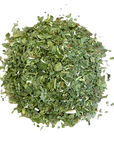


Spilanthes
Botanical name: Acmella oleracea
^Organic
Spilanthes, commonly known as toothache plant or eyeball plant, is an herbaceous perennial belonging to the Asteraceae family. This vibrant plant is native to tropical regions of the Americas and Africa, thriving in warm, moist environments. Spilanthes is characterized by its small, yellow, and red flowers that resemble tiny daisies, and its leaves are known for their distinctive, slightly fuzzy texture.
In herbal medicine, spilanthes has been traditionally valued for its potential analgesic properties, particularly for alleviating toothaches and oral discomfort. The leaves and flowers can be consumed fresh or made into teas, tinctures, and extracts, offering a unique, tingling sensation due to the presence of a compound called spilanthol. This plant is also celebrated for its potential benefits in supporting the immune system and digestive health. Spilanthes has been used in various cultures for its medicinal properties, often included in traditional remedies for oral health.*
*These statements have not been evaluated by the Food and Drug Administration. This product is not intended to diagnose, treat, cure, or prevent any disease. For educational purposes only.



